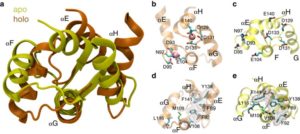Nat Commun. 2016 Apr 4;7:10910. doi: 10.1038/ncomms10910.
Finally, our model predicts a novel binding interface that is well-populated in the Ca(2+)-bound regime and, thus, a candidate for pharmacological intervention.
Calmodulin (CaM) is a ubiquitous Ca(2+) sensor and a crucial signalling hub in many pathways aberrantly activated in disease. However, the mechanistic basis of its ability to bind diverse signalling molecules including G-protein-coupled receptors, ion channels and kinases remains poorly understood. Here we harness the high resolution of molecular dynamics simulations and the analytical power of Markov state models to dissect the molecular underpinnings of CaM binding diversity. Our computational model indicates that in the absence of Ca(2+), sub-states in the folded ensemble of CaM’s C-terminal domain present chemically and sterically distinct topologies that may facilitate conformational selection. Furthermore, we find that local unfolding is off-pathway for the exchange process relevant for peptide binding, in contrast to prior hypotheses that unfolding might account for binding diversity.Finally, our model predicts a novel binding interface that is well-populated in the Ca(2+)-bound regime and, thus, a candidate for pharmacological intervention.

